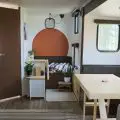Hey! This site is reader-supported and we earn commissions if you purchase products from retailers after clicking on a link from our site.
Do you need to repair or replace your interior RV wall paneling and aren’t sure where to start?
Whether you’re ready to upgrade the look of your RV interior or need to fix water or other damage to the wall panels, this guide will take you through the entire process.
Inside, you’ll get the details on what material RV manufacturers use for walls, how they attach, and tips for removing and replacing RV wall paneling. You’ll also find answers to RV wall paneling FAQs.
When you follow this guide, you can fix your RV wall panels successfully and get back to camping!
Common RV Paneling Material
RV manufacturers use the following wall paneling in travel trailers, fifth wheels, and motorhomes.
Azdel
Azdel is a composite material made from blending fiberglass and polypropylene. Azdel is most common in four-season travel trailers because it offers better moisture resistance and insulating qualities.
Other benefits of Azdel versus wood products include:
- High strength
- Lightweight
- Emits no odor
- Environmentally-friendly
- Buffers vibration and sound
You can choose to replace RV wall panels with Adzel, which you can find through RV supply stores.
Vinyl
Vinyl wall panels are more common for exterior RV applications, but you can find some products in 4′ x 8′ sheets for interior use at some home improvement stores. This is the very same material that vinyl records are made of.
The biggest benefits of vinyl are that the material is 100 percent waterproof and lightweight. However, the material isn’t durable over time, as it dries out and can crack from bumps and vibrations during travel.
Plywood
Plywood panels were standard in older RVs but are rare in modern campers due to the weight and water damage, mold, or rot if your RV leaks and due to harder maintenance of RV moisture control.
The benefits of using plywood are its strength and rigidity. Plus, it allows you to hang lots of decorative items anywhere you like on your RV walls.
HDF (High-Density Fiberboard)
HDF is possibly the most common material recreational vehicle manufacturers use to panel RV interiors.
The 1/8th-inch-thick panels are strong and thin, making them ideal for RV travel stress and resist water better than wood or MDF.
The panel surface is bonded with decorative vinyl coating, so it needs no further treatment once you install it.
Most major RV brands sell HDF replacement RV wall panels to match their most popular models, which is something to look into if you want to avoid a mismatched interior.
When buying any new RV paneling, don’t forget to purchase thin trim strips to cover the seams between each panel.
How RV Panels Attach to Walls
RV wall panels attach to the camper’s wood framing using small staples or brad nails.
For thicker plywood, it’s more likely that the manufacturer will use a mid-size nail or screw to attach the wall panels securely.
You should also expect to find an adhesive between each stud and the back of the paneling, which increases the strength of the entire wall and decreases movement.
After all the RV wall paneling is in place, the manufacturer covers each joint vertically with a long thin strip of matching material, using a fastener every two feet or so. This strip covers all the fasteners along the edge of each panel and hides gaps between the RV paneling sheets, making the wall look seamless.
How to Remove RV Paneling
Removing RV paneling isn’t as difficult as you may think. The key is not to cut it with a power saw or smash the walls with a hammer as you would if you were removing old drywall in a house.
RV walls are generally 3-inches thick, and plenty of wiring (your RV electrical system), plumbing, and insulation could be hiding behind the wall panels. Hacking at the walls may lead to expensive damage.
The first step to removing RV wall paneling is taking off outlet covers, lights, door trim, or other surface-mounted items. Next, run a utility knife through any caulk along the panels’ edges, finish strips, and ceiling and floor edges.
You may also need to cut the wall panels along the edges of cabinets or built-in furniture to remove a piece since they are often put in place after the wall paneling is on.
The next step is to take a pry bar, slide it under the finishing strips and the paneling, and gently pull or twist it toward you to loosen the strip from the wall. Work your way along until you pull all the nails or staples out with the strip. You’ll now see the edges of the large wall panel sheets that were hiding underneath the strip.
The final step is to work the pry bar between the stud and panel edge, to lift it off the wood. Once a section is lifted, work up and down along the stud until the panel is loose. Then, move across to the other side of the panel and work that edge free.
Once the sides are done, grab a loose edge and curl it toward you. This action should pop the adhesive and other nails from the middle studs and make the removal of the panel a bit easier.
If the panel is of poor quality or has heavy moisture damage, the material will more likely break off in chunks and will require a bit more work to remove.
Lastly, if you see any nails or staples in the studs after the panel is off, use a nail puller or pliers to remove them.
PRO TIP: Keeping panel pieces whole when you remove them allows you to use them as a template when cutting your replacement panels. Take the time to number or mark each panel and corresponding wall studs to know which panel goes where.
Things to Consider Before Replacing RV Wall Panels
Before you start tearing out the walls in your RV, you need to assess a few things.
First, do the wall panels you want to replace have damage from a water leak or continual banging or scratching from doorknobs, feet, or pets?
Fixing the cause of such problems to your wall paneling needs to be a priority, or you’ll find yourself replacing the paneling again in short order.
Seal any leaks, and replace any wall studs that show signs of damage or rot.
Troubleshoot ways to beef up areas of the wall that get heavy abuse. For example, you may select a thicker RV wall panel material or cover thin paneling with a layer of wood slats or other more durable material over the areas of concern.
Now is also the time to consider moving or adding electrical outlets, lights, or plumbing lines since you’ll have access to these components once the wall panels are off.
Choosing the Best RV Paneling Replacement
While you can opt for an exact wall panel replacement for your RV renovation, you do have the option to use other materials if you think they’ll be more suitable for your needs.
The only two things you must consider before switching to a new RV wall panel material are the overall weight and if any extra thickness will prevent it from fitting correctly around cabinets or furniture or laying flush with existing paneling.
All RVs post a gross vehicle weight rating (GVWR) that includes the items and supplies inside your camper and materials in the build.
If you increase the weight of your walls by a couple of hundred pounds by switching to plywood or MDF, you must lighten your load by that amount elsewhere in the RV.
How to Install RV Panels
Once you have the underlying RV wall studs, wiring, plumbing, and insulation ready for new wall panels, it’s time to start measuring each section and cutting your paneling to fit.
The critical step is to cut each panel (if necessary), so the outer edges fall halfway across a stud. It would be best to mark all studs on the ceiling and floor with painter’s tape so you know where to nail down the paneling for the strongest attachment.
Set up a nailgun with brads or staples, or fill a construction apron with nails or screws. Put a tube of wall panel adhesive into a caulking gun, so you’re ready for action. You’ll also want a carpenter’s level to align the first panel, so the rest falls into place perfectly.
Start along a corner when replacing an entire wall of panels. Run a bead of adhesive over each stud the RV wall paneling replacement will cover.
Don’t forget to pre-cut holes in the paneling for outlets or lights so that you can reinstall those components quickly.
Line up your first wall panel, so the edge is centered and vertically level along with the studs. Then, using a nail gun, hammer, or drill, adhere the paneling to the stud using the appropriate fastener.
Repeat these steps for replacing RV wall paneling until the interior is complete.
Next, cut your thin finishing strips to length and install them over the seams between panels to finish the project. Use adhesive to prevent the strips from popping loose, and place a nail or staple every 12-18 inches.
Once everything is in place, go over any obvious nail holes with a bit of matching spackle and let dry. Now, you’re ready to reinstall any light fixtures, outlet covers, and door trim to complete the project.
The Perfect DIY Project
New RV walls can be a weekend DIY project that will transform the look of your camper, whether you need to fix paneling damage or want to upgrade the interior design.
By using the best tips to replace RV wall panels in this guide, you’ll complete your project fast and get back to enjoying fun camping adventures!
RV Wall Paneling Replacement FAQs
Can I Paint Interior RV Wall Panels?
Yes, instead of replacing RV wall paneling to suit your taste, you can paint it for a quicker and much more affordable solution.
You may also need to paint replacement RV wall panels to match existing walls or make them an accent color when the panels aren’t the same material or thickness as the old panels.
Because most RV wall paneling features a slick vinyl coating, you’ll need to prepare the surface for the best results.
The top tip for painting RV wall paneling is to first wash the walls with a TSP (Trisodium phosphate) cleaner to remove grease, fingerprints, and dirt so the paint can adhere properly.
For extra durability, use a bonding primer as the first coat that is compatible with the paneling surface.
Once the primer dries, you should apply two coats of your decorative paint color. Satin, semi-gloss, or gloss paint is more durable than a flat or eggshell finish for RVs.
Can I Wallpaper Over RV Wall Panels?
Traditional wallpaper isn’t a good idea in an RV. Temperature extremes can quickly loosen the glue that holds the paper to the paneling, even with a good primer to help the paper stick to the wall.
However, you can wallpaper over RV wall paneling using the newer peel-and-stick removable wallpaper products. These wallpapers are thicker, resistant to moisture, and more flexible than traditional wallpapers, so they do well in an RV environment.
What’s the Best Way to Hang Things on Interior RV Walls?
If you want to hang decor inside your RV, the best place to secure a nail or screw is at any of the trim strips over the seams of the paneling or where you see nail holes or staples.
You’ll find a wood stud underneath these strips or nails in the wall panel that provides the most robust support for your decorations.
Trying to hang items on the paneling between studs will lead to failure, as the thin wall panels aren’t strong enough to hold things secure with continual RV movements. Another issue is accidentally nailing or screwing into water or electrical lines running between the studs.
Many RVers swear by Command hooks or similar removable-adhesive plastic hangers to display items wherever they want. However, you do need to match the hook rating to the weight of the decor piece. Read the label for weight ratings to find a good match.
Follow hook installation instructions carefully, as most require cleaning the area with alcohol and letting the hook set for 24 hours before hanging decor. Expect things to fall off your RV walls if you rush the process.
Is It Safe to Install Tile Over RV Wall Panels?
If you love the look of ceramic tile, you can technically install them in your RV if you first put cement board panels behind that area.
However, the sheer weight of cement board and ceramic tiles can cause issues with exceeding your RV weight rating.
The next best thing to get the look of ceramic tiles is to purchase lightweight peel-and-stick tiles that easily install over existing RV wall paneling.
RVers love the look of these vinyl tiles in the kitchen and bathroom, and you can find an incredible number of colors, patterns, and designs to customize the look of your camper online or at home improvement centers.
The trick to installing peel-and-stick tiles over RV wall paneling is to clean the surface with TSP and remove any vertical trim strips so the tiles can lay even across the entire surface.





